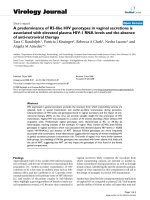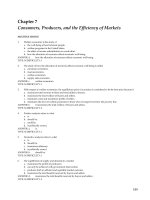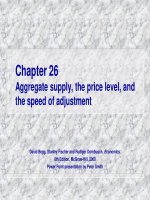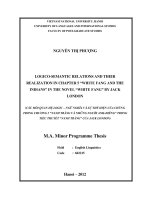Chapter 15 Price Levels and the Exchange Rate in the Long Run
Bạn đang xem bản rút gọn của tài liệu. Xem và tải ngay bản đầy đủ của tài liệu tại đây (1.24 MB, 54 trang )
Chapter 15
Price Levels
and the
Exchange Rate
in the Long Run
Slides prepared by Thomas Bishop
Preview
• Law of one price
• Purchasing power parity
• Long run model of exchange rates: monetary
approach
• Relationship between interest rates and inflation:
Fisher effect
• Shortcomings of purchasing power parity
• Long run model of exchange rates: real exchange
rate approach
• Real interest rates
Copyright © 2006 Pearson Addison-Wesley. All rights reserved.
15-2
The Behavior of Exchange Rates
• What models can predict how exchange rates
behave?
In last chapter we developed a short run model and a long
run model that used movements in the money supply.
In this chapter, we develop 2 more models, building on the
long run approach from last chapter.
Long run means that prices of goods and services and
factors of production that build those goods and services
adjust to supply and demand conditions so that their markets
and the money market are in equilibrium.
Because prices are allowed to change, they will influence
interest rates and exchange rates in the long run models.
Copyright © 2006 Pearson Addison-Wesley. All rights reserved.
15-3
The Behavior of Exchange Rates (cont.)
• The long run models are not intended to be
completely realistic descriptions about how
exchange rates behave, but ways of
generalizing how market participants form
expectations about future exchange rates.
Copyright © 2006 Pearson Addison-Wesley. All rights reserved.
15-4
Law of One Price
• The law of one price simply says that the
same good in different competitive markets
must sell for the same price, when
transportation costs and barriers between
markets are not important.
Why? Suppose the price of pizza at one restaurant
is $20, while the price of the same pizza at a
similar restaurant across the street is $40.
What do you predict to happen?
Many people would buy the $20 pizza, few would
buy the $40.
Copyright © 2006 Pearson Addison-Wesley. All rights reserved.
15-5
Law of One Price (cont.)
Due to the increased demand, the price of the $20
pizza would tend to increase.
Due to the decreased demand, the price of the $40
pizza would tend to decrease.
People would have an incentive to adjust their
behavior and prices would tend to adjust to reflect
this changed behavior until one price is achieved
across markets (restaurants).
Copyright © 2006 Pearson Addison-Wesley. All rights reserved.
15-6
Law of One Price (cont.)
• Consider a pizza restaurant in Seattle one across the
border in Vancouver.
• The law of one price says that the price of the same
pizza (using a common currency to measure the
price) in the two cities must be the same if barriers
between competitive markets and transportation costs
are not important:
PpizzaUS = (EUS$/Canada$) x (PpizzaCanada)
PpizzaUS = price of pizza in Seattle
PpizzaCanada = price of pizza in Vancouver
EUS$/Canada$ = US dollar/Canadian dollar exchange rate
Copyright © 2006 Pearson Addison-Wesley. All rights reserved.
15-7
Purchasing Power Parity
• Purchasing power parity is the application of the law
of one price across countries for all goods and
services, or for representative groups (“baskets”) of
goods and services.
PUS = (EUS$/Canada$) x (PCanada)
PUS = price level of goods and services in the US
PCanada = price level of goods and services in Canada
EUS$/Canada$ = US dollar/Canadian dollar exchange rate
Copyright © 2006 Pearson Addison-Wesley. All rights reserved.
15-8
Purchasing Power Parity (cont.)
• Purchasing power parity implies that
EUS$/Canada$ = PUS/PCanada
The price levels adjust to determine the exchange rate.
If the price level in the US is US$200 per basket, while the
price level in Canada is C$400 per basket, PPP implies that
the US$/C$ exchange rate should be US$200/C$400 =
US$ 1/C$ 2
Purchasing power parity says that each country’s currency
has the same purchasing power: 2 Canadian dollars buy the
same amount of goods and services as does 1 US dollar,
since prices in Canada are twice as high.
Copyright © 2006 Pearson Addison-Wesley. All rights reserved.
15-9
Purchasing Power Parity (cont.)
• Purchasing power parity comes in 2 forms:
• Absolute PPP: purchasing power parity that has
already been discussed. Exchange rates equal price
levels across countries.
E$/€ = PUS/PEU
• Relative PPP: changes in exchange rates equal
changes in prices (inflation) between two periods:
(E$/€,t - E$/€, t –1)/E$/€, t –1 = US, t - EU, t
where t = inflation rate from period t-1 to t
Copyright © 2006 Pearson Addison-Wesley. All rights reserved.
15-10
Monetary Approach to Exchange Rates
• Monetary approach to the exchange rate:
uses monetary factors to predict how
exchange rates adjust in the long run.
It uses the absolute version of PPP.
It assumes that prices adjust in the long run.
In particular, price levels adjust to equate real
(aggregate) money supply with real (aggregate)
money demand. This implies:
PUS = MsUS/L (R$, YUS)
PEU = MsEU/L (R€, YEU)
Copyright © 2006 Pearson Addison-Wesley. All rights reserved.
15-11
Monetary Approach
to Exchange Rates (cont.)
• To the degree that PPP holds and to the
degree that prices adjust to equate real
money supply with real money demand, we
have the following prediction:
• The exchange rate is determined in the long
run by prices, which are determined by the
relative supply of money across countries and
the relative real demand of money across
countries.
Copyright © 2006 Pearson Addison-Wesley. All rights reserved.
15-12
Monetary Approach
to Exchange Rates (cont.)
Predictions about changes in:
1. Money supply: a permanent rise in the domestic
money supply
causes a proportional increase in the domestic price level,
causing a proportional depreciation in the domestic
currency (through PPP).
same prediction as long run model without PPP
2. Interest rates: a rise in the domestic interest rate
lowers domestic money demand,
increasing the domestic price level,
causing a proportional depreciation of the domestic
currency (through PPP).
Copyright © 2006 Pearson Addison-Wesley. All rights reserved.
15-13
Monetary Approach
to Exchange Rates (cont.)
3. Output level: a rise in the domestic output level
•
raises domestic money demand,
decreasing the domestic price level,
causing a proportional appreciation of the domestic
currency (through PPP).
All 3 changes affect money supply or money
demand, thereby causing prices to adjust to
maintain equilibrium in the money market, thereby
causing exchange rates to adjust to maintain PPP.
Copyright © 2006 Pearson Addison-Wesley. All rights reserved.
15-14
Monetary Approach
to Exchange Rates (cont.)
• A change in the level of the money supply results in a
change in the price level.
• A change in the money supply growth rate results in a
change in the growth rate of prices (inflation).
Other things equal, a constant growth rate in the money
supply results in a persistent growth rate in prices
(persistent inflation) at the same constant rate.
Inflation does not affect the productive capacity of the
economy and real income from production in the long run.
Inflation, however, does affect nominal interest rates. How?
Copyright © 2006 Pearson Addison-Wesley. All rights reserved.
15-15
The Fisher Effect
• The Fisher effect (named affect Irving Fisher)
describes the relationship between nominal interest
rates and inflation.
Derive the Fisher effect from the interest parity condition:
R$ - R€ = (Ee$/€ - E$/€)/E$/€
If financial markets expect (relative) PPP to hold, then
expected exchange rate changes will equal expected inflation
between countries: (Ee$/€ - E$/€)/E$/€ = eUS - eEU
R$ - R€ = eUS - eEU
The Fisher effect: a rise in the domestic inflation rate causes
an equal rise in the interest rate on deposits of domestic
currency in the long run, with other things constant.
Copyright © 2006 Pearson Addison-Wesley. All rights reserved.
15-16
Monetary Approach to Exchange Rates
• Suppose that the Federal Reserve
unexpectedly increases the money supply
growth rate at time t0.
• Suppose also that the inflation rate is π in the
US before t0 and π + π after this time.
Suppose inflation is consistently 0% in Europe.
• The interest rate adjusts according to the
Fisher effect to reflect this higher inflation rate.
Copyright © 2006 Pearson Addison-Wesley. All rights reserved.
15-17
Monetary Approach
to Exchange Rates (cont.)
(a) US money supply, MUS
(b) dollar interest rate, R$
R$2 = R$1 +
Slope = +
MUS, t0
R$1
Slope =
t0
Time
Copyright © 2006 Pearson Addison-Wesley. All rights reserved.
t0
Time
15-18
Monetary Approach
to Exchange Rates (cont.)
Copyright © 2006 Pearson Addison-Wesley. All rights reserved.
15-19
Monetary Approach
to Exchange Rates (cont.)
Copyright © 2006 Pearson Addison-Wesley. All rights reserved.
15-20
Monetary Approach
to Exchange Rates (cont.)
• The increase in nominal interest rates decreases real
money demand.
• To maintain equilibrium in the money market, prices
must jump so that PUS = MsUS/L (R$, YUS).
• To maintain PPP, the exchange rate will then jump
(the dollar will depreciate): E$/€ = PUS/PEU
• Thereafter, the money supply and prices grow at rate
π + π and the domestic currency depreciates at the
same rate.
Copyright © 2006 Pearson Addison-Wesley. All rights reserved.
15-21
Monetary Approach
to Exchange Rates (cont.)
(a) US money supply, MUS
(b) dollar interest rate, R$
R$2 = R$1 +
Slope = +
MUS, t0
R$1
Slope =
t0
(c) US price level, PUS
Time
t0
(d) exchange rate, E$/€
Slope = +
Slope =
Time
Slope = +
Slope =
t0
Time
Copyright © 2006 Pearson Addison-Wesley. All rights reserved.
t0
Time
15-22
The Role of Inflation and Expectations
In the model long run model without PPP,
• changes in money supply levels lead to changes in
price levels.
• There is no inflation in the long run, but only during
the transition to the long run equilibrium.
• During the transition, inflation causes the nominal
interest rate to increase to its long run rate.
• Expectations of inflation cause the expected return on
foreign currency to increase, making the domestic
currency depreciate before the transition period.
Copyright © 2006 Pearson Addison-Wesley. All rights reserved.
15-23
The Role of Inflation
and Expectations (cont.)
• In the monetary approach (with PPP), the rate of
inflation increases permanently because the growth
rate of the money supply increases permanently.
• With persistent inflation (above foreign inflation), the
monetary approach also predicts an increase in the
nominal interest rate.
• Expectations of higher domestic inflation cause the
purchasing power of foreign currency to increase
relative to the purchasing power of domestic currency,
thereby making the domestic currency depreciate.
Copyright © 2006 Pearson Addison-Wesley. All rights reserved.
15-24
The Role of Inflation
and Expectations (cont.)
• In the long run model without PPP,
expectations of inflation cause the exchange
rate to overshoot (cause the domestic
currency to depreciate more than) its long run
value.
• In the monetary approach (with PPP), the
price level adjusts with expectations of
inflation, causing the domestic currency to
depreciate, but with no overshooting.
Copyright © 2006 Pearson Addison-Wesley. All rights reserved.
15-25









